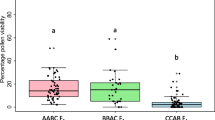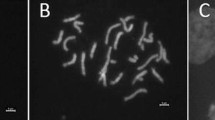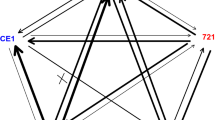Summary
Cross-compatibility of species in section Arachis Krap. et Greg. nom. nud., and chromosome pairing and pollen fertility in their interspecific F1 hybrids were studied to further understand the phylogenetic relationships among these species. Except those with A. batizocoi Krap. et Greg. nom. nud., hybrids between diploid species have near normal bivalent frequency (9.1–9.8) and moderate to high pollen fertility (60–91%). Hybrids between A. batizocoi and other species have low bivalent frequency (5.2–6.9) and very low pollen fertility (3–7%). These results confirm the earlier separation of these species into two groups based on karyomorphology and Mahalanobis D2 calculated on arm ratios. These studies also provide a picture of relative affinities between A. batizocoi, the lone member of one cluster, and the other species, and among the rest of the species. They also indicate that the basic chromosome complement in the two groups of species is the same. Chromosome pairing in triploid hybrids, (A. hypogaea L. X diploid wild species), suggests that A. batizocoi is the closest diploid relative of A. hypogaea. It is closer to A. hypogaea subspecies fastigiata Waldron than to A. hypogaea subspecies hypogaea Krap. et. Rig. Other diploid species of the section Arachis are equidistant from A. hypogaea, and have the same genome which has strong homology to one of the genomes of A. hypogaea. Based on the present results, the two tetraploid species, A. monticola Krap. et Rig. and A. hypogaea can be recognised as two forms of the same species. Breeding implications have been discussed in the light of chromosome behaviour observed in hybrids of A. hypogaea X diploid species, and on the presumptions that A. hypogaea has an AABB genomic constitution, and that among the diploid species, the ‘B’ genome is present in A. batizocoi while the ‘A’ genome is common to the other diploid species of section Arachis.
Similar content being viewed by others
References
Abdou YAM, Gregory WC, Cooper WE (1974) Sources and nature of resistance to Cercospora arachidicola Hori. and Cercosporidium personatum (Berk and Curt) Deighton in Arachis species. Peanut Sci 1:6–11
Burkart A (1939) Estudios sistematicos sobre las Leguminosashedisareas de la republica Argentina y regiones adyacentes. Darwiniana 3:117–302
Gibbons RW, Turley AC (1967) ARC Grain legume pathology research team. In: Botany and plant breeding. Ann Rep Agric Res Counc Central Africa, pp 86–90
Gregory MP, Gregory WC (1979) Exotic germ plasm of Arachis L. interspecific hybrids. J Hered 70:185–193
Gregory WC, Krapovickas A, Gregory MP (1980) Structure, variation, evolution and classification in Arachis. In: Summerfield RJ, Buntings AH (eds) Advances in legume science. Publ R Bot Gard, Kew, pp 469–481
Grestel DV (1976) Tobacco. In: Simmonds RW (ed) Evolution of crop plants. Longman, London New York, pp 273–277
Hebert TT, Stalker HT (1981) Resistance to peanut stunt virus in cultivated and wild Arachis species. Peanut Sci 8:45–47
Husted L (1936) Cytological studies of the peanut, Arachis. 2. Chromosome number, morphology and behaviour and their application to the origin of cultivated forms. Cytologia 7:396–423
ICRISAT (1982) (International Crops Research Institute for the Semi-Arid Tropics) Annu Rep 1981. Patancheru AP, India
Krapovickas A, Rigonoi VA (1957) Neuvas especies de Arachis vinculadas al problema del origen del mani. Darwiniana 11:431–455
Mac Key J (1975) The boundaries and subdivision of the genus Triticum. Proc 12th Int Bot Congr, Leningrad 1975
Moss JP (1980) Wild species in the improvement of groundnuts. In: Summerfield RJ, Bunting AH (eds) Advances in legume science. Publ R Bot Gard, Kew pp 525–535
Palanisamy KS, Raman VS (1980) Consequences of hybridism in Spanish and Virginia groundnuts (Arachis hypogaea L.). Oleagineux 35:311–322
Phillips LL (1976) Cotton. In: Simmonds RW (ed) Evolution of crop plants. Longman, London New York, pp 196–200
Raman VS, Kesavan PC (1962) Studies on a diploid interspecific hybrid in Arachis. Nucleus 5:123–126
Singh AK, Moss JP (1982) Utilization of wild relatives in genetic improvement of Arachis hypogaea L. 2. Chromosome complement of species of section Arachis. Theor ApplGenet 61:305–314
Singh AK, Sastri DC, Moss JP (1980) Utilization of wild Arachis species at ICRISAT. In: ICRISAT (International Crops Research Institute for the Semi-Arid Tropics). Proc Int Workshop Groundnuts. Patancheru AP, India, pp 82–90
Smartt J (1964) Cross-compatibility relationship between the cultivated peanut Arachis hypogaea L. and other species of the genus Arachis. PhD Thesis, North Carolina State University, Raleigh
Smartt J, Gregory WC (1967) Interspecific cross-compatibility between the cultivated peanut Arachis hypogaea L. and other members of the genus Arachis. Oleagineux 22: 455–459
Smartt J, Gregory WC, Gregory MP (1978a) The genomes of Arachis hypogaea L. 1. Cytogenetic studies of putative genome donors. Euphytica 27:665–675
Smartt J, Gregory WC, Gregory MP (1978b) The genomes of Arachis hypogaea L. 2. The implications in interspecific breeding. Euphytica 27:677–680
Spielman IV, Burge AP, Moss JP (1979) Chromosome loss and meiotic behaviour in interspecific hybrids in the genus Arachis and their implications in breeding for disease resistance. Z Pflanzenzücht 83:236–250
Stalker HT, Wynne JC (1979) Cytology of interspecific hybrids in section Arachis of peanuts. Peanut Sci 6:110–114
Stebbins GL (1971) Chromosome evolution in higher plants. Addison Wesley, Reading
Subrahmanyam P, Gibbons RW, Nigam SN, Rao VR (1980) Screening methods and further sources of resistance to peanut rust. Peanut Sci 7:10–12
Subrahmanyam P, Moss JP, Rao VR (1983) Resistance to peanut rust in wild Arachis species. Plant Dis 67:209–212
Author information
Authors and Affiliations
Additional information
Communicated by J. MacKey
Submitted as Journal Article No. 328 by the International Crops Research Institute for the Semi-Arid Tropics (ICRISAT)
Rights and permissions
About this article
Cite this article
Singh, A.K., Moss, J.P. Utilisation of wild relatives in the genetic improvement of Arachis hypogaea L.. Theoret. Appl. Genetics 68, 355–364 (1984). https://doi.org/10.1007/BF00267889
Received:
Accepted:
Issue Date:
DOI: https://doi.org/10.1007/BF00267889




